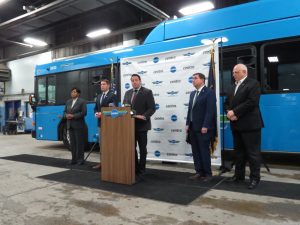New York Gov. Andrew Cuomo on Jan. 6 announced details of a more than $2 billion tax-relief proposal he says is designed to increase economic opportunity and attract and grow businesses across the state. Cuomo’s office is citing “responsible fiscal management in state government” as the reason why New York has gone from a $10 […]
Get Instant Access to This Article
Become a Central New York Business Journal subscriber and get immediate access to all of our subscriber-only content and much more.
- Critical Central New York business news and analysis updated daily.
- Immediate access to all subscriber-only content on our website.
- Get a year's worth of the Print Edition of The Central New York Business Journal.
- Special Feature Publications such as the Book of Lists and Revitalize Greater Binghamton, Mohawk Valley, and Syracuse Magazines
Click here to purchase a paywall bypass link for this article.
New York Gov. Andrew Cuomo on Jan. 6 announced details of a more than $2 billion tax-relief proposal he says is designed to increase economic opportunity and attract and grow businesses across the state.
Cuomo’s office is citing “responsible fiscal management in state government” as the reason why New York has gone from a $10 billion deficit to an expected $2 billion surplus.
Based on current projections, the state will see a surplus of about $2 billion by fiscal year 2016-17 if spending growth is held to two percent annually, according to Cuomo’s office.
Given the projected surplus, Cuomo proposes a more than $2 billion package of tax-relief measures to help New York residents and businesses.
Cuomo’s proposals include a two-year freeze on property taxes, cutting business taxes and treating businesses “more fairly,” a real-property tax credit for manufacturers, and eliminating the tax rate on Upstate manufacturers. The governor also proposes accelerating the phase-out of the 18-A surcharge, which is the two percent temporary utility assessment levied on commercial electric, gas, water and steam-utility bills for industrial customers.
The news release from the governor’s office explains its rationale for the business-related proposals involved.
New York’s corporate-franchise tax is “largely outdated” and its “complexity” results in lengthy and complex audit processes that take businesses years to resolve, Cuomo’s office said.
To streamline the tax structure and provide relief for businesses, Cuomo recommends merging the bank tax into the corporate-franchise tax and lowering the rate to 6.5 percent – the lowest rate since 1968, the office said.
Cuomo also proposes the creation of a refundable credit against corporate and personal- income taxes that would be equal to 20 percent of a firm’s annual real-property taxes. The credit would provide $136 million in tax relief to the manufacturing sector, according to Cuomo’s office.
Additionally, Cuomo recommends the elimination of the corporate income-tax rate for Upstate manufacturers, which is intended to encourage the growth of manufacturing.
The proposal would provide an additional $25 million in tax relief for Upstate businesses and complement the proposal to reduce property taxes on manufacturers, Cuomo’s office said.
Proposals to streamline tax collection will offset any costs of the tax-relief package exceeding $2 billion.
The proposals will increase revenue through improved audits, Cuomo contends.
Local reaction
These proposals stand to have an “immediate” impact on New York’s businesses and residents, including property-tax relief for homeowners, targeted tax reductions for upstate manufacturers, and estate-tax reform that will “greatly benefit” small-business owners, Robert Simpson, president of CenterState CEO, said in a statement issued Jan. 6.
“It is refreshing to start the year with a series of reform proposals that could meaningfully move the state forward economically, instead of preparing to fend off further escalations of New York’s already crushing tax burden,” Simpson said.
CenterState CEO believes the state is taking “great strides” to build a “competitive” business climate. The organization hopes state-government leaders will implement “as many of these measures as possible,” he added.
The proposed elimination of the corporate tax rate for Upstate manufacturers, a 20 percent tax credit of a manufacturer’s property taxes, and the proposal calling for an immediate elimination of the 18-A energy-tax surcharge will send a message that New York wants to grow its manufacturing sector, Randall Wolken, president of the DeWitt–based Manufacturers Association of Central New York, said in a statement.
“It is well-known that manufacturing is the backbone to a thriving economy. Providing New York state manufacturers with the much-needed tax breaks will enable them to do what they do best: create high-quality manufactured goods, sustain and grow family supporting well-paying jobs, and generate much-needed revenue for our state,” Wolken said.
Contact Reinhardt at ereinhardt@cnybj.com



